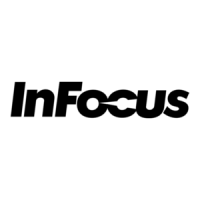27
Optimizing video images
After your video device is connected properly and the image is on the
screen, you can optimize the image using the onscreen menus. For general
information on using the menus, see page 28.
• Adjust the Keystone, Contrast, Brightness, Color, Tint or Sharpness in
the Basic Picture menu (page 29).
• Change the Aspect Ratio. Choose the o
ption that best fits your input
source (page 29).
• Adjust the Color Temperature. Select a listed warmth value (page 30).
• Turn on Overscan to remove noise on the edges of the image (page 30).
Customizing the projector
You can customize the projector for your specific setup and needs. See
page 31 to page 32 for details on these features.
• For rear projection, turn Re
ar Project on in the Setup menu.
• For ceiling mounted projection, tu
rn Ceiling Mount on in the Setup
menu.
• Specify which source the projector che
cks first for active video during
power-up.
• Specify the function
of the Custom key on the remote.
• Turn the projector’s display messages on and off.
• Turn on power saving features.
• Specify appearance of blank
screen and startup screen.
• Specify the language viewed on the menus.
Dynamic Messaging
Using command codes, text messages can be sent for display by the
projector (and all other InFocus projectors with the Dynamic Messaging
feature) over a network or serial connection. Text is shown on top of
whatever else is being displayed, and can be shown in ticker tape format or
in a box, with optional beep tone alert. This is a great way to display urgent
alert messages to employees, and simply requires a connection to the
projector’s RS-232 serial control or LAN connector. Command codes for
executing Dynamic Messaging are in the Appendix and available on our
website at www.infocus.com/support.

